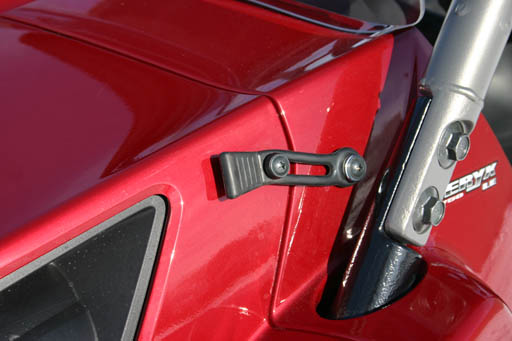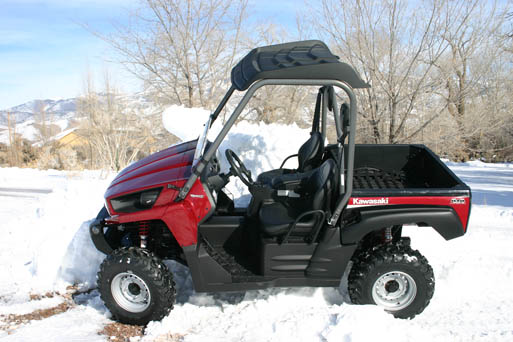

2010 KAWASAKI TERYX LE
The Teryx was first introduced in February of 2008. From the start it proved to be a great side by side with a lot of good things going for it. The main ‘good thing’ that it lacked though was fuel injection. That was remedied in the 2009 model along with a host of other revisions. Now, for 2010 Kawasaki has made a few more evolutionary changes to the Teryx that include a new look and a front hood that opens for maintenance and cleaning.
When it was first introduced, many folks commented that the Teryx looked too much like a Rhino clone. I sure wish they would have kept their yaps shut, as Kawasaki’s answer to that was to replace the ‘better looking than a Rhino’ front clip with a look that nobody’s bound to copy! Let’s just say I don’t like the new looks that much and we’ll move on.
The interior remains unchanged for 2010 so just as before you’ll find the seats quite comfortable with pronounced side bolsters to hold you in during hard cornering and off-camber situations. Unfortunately the seats are still not adjustable fore and aft but the reach to the pedals and the steering wheel is a good fit for most people from around 5’6” to maybe 6’ 3”. On the floorboard, there’s a nice dead pedal to rest your left foot when not using it for braking. On the center console between the seats sits two levers, the shifter and the ratcheting lever for locking in the front differential in varying degrees of lock. With the lever forward the front differential is fully open. Pulling the lever back, it ratchets to lock the differential in, in varying degrees all the way to full lock. The differential can be loosened with a push of the button on the top of the lever. It’s a very trick way to control the front differential and easy to work. And it works at any speed. Just to the right of the dif lever is the easy to use shifter. The simple pattern has neutral in the center, high and low ranges forward from that and reverse to the rear. The shifter engages the gears with an almost fluid-like precision as long as you are at a complete stop.
On the center of the dash is a nice digital gauge that includes a digital speedometer, odometer, trip odometers, clock and 4wd indicator as well as lights for the parking brake, neutral reverse and oil and water temps. Just below the gauges is a slick pull-out cup holder. To the right of the gauges is the 12-volt accessory plug. Also on the right, in front of the passenger is a large, well-sealed storage compartment. On the left side of the gauges is the ignition switch, and the switch for 2wd and 4wd. To the left of the steering wheel is the knob for the headlights and taillights. Below that is the foot-operated parking brake that is released by a small hand lever just above it.
The Teryx is powered by a fuel injected, 750cc 90-degree V-Twin that is both great sounding and powerful. The digital fuel injection system was added in 2009 along with an improved intake system to had airflow and decrease the sound in the cabin. The new fuel injection system has not only helped the cold weather starting and high altitude performance, but has provided a significant increase in performance that is easily noticed from the moment the throttle pedal is pushed. Another benefit to a digital fuel injection system is the control it gives Kawasaki over the engine’s functions. A feature added this year is an ignition cutout to keep from driving the Teryx at speed with the parking brake on.
For 2010 Kawasaki has made several upgrades to the engine’s cooling system. The radiator’s cooling fan is now larger to move more air through the radiator. There’s also a larger-diameter hose for greater coolant flow. These modifications all help to keep the engine cooler when the going gets slow and rough. Also, the coolant catch tank has been moved to the front of the machine where it’s now much more easily accessible under the new tilt-open front clip.
The Teryx’s incredible power is transferred to the driveline via a CVT transmission that uses Kawasaki’s electric actuated braking system to apply pressure to the belt to simulate actual engine braking. And this it does seamlessly. The transmission ratios were revised in 2009 for the added power output and a rock crawling sensor was added to keep the belt from being overloaded in slow, technical crawling. This sensor can detect when the transmission’s belt slips and retards the ignition to lower the rpms. The CVT unit has an aluminum cover to help the transmission run cooler, and the intake system has a raised snorkel to bring more air in from a higher location. The driveline components were all strengthened in ’09 to handle the added stress of the new power increase and assure reliability. The 7.4 gallon fuel tank is mounted under the passenger seat.
Both the front and rear suspensions are dual a-arms with 7.5 inches of wheel travel. The front has 5-way preload adjustable gas-charged shocks while the rear arms have gas-charged reservoir shocks with a screw-type pre-load adjustment. The rear sway bar was modified for ’09 to allow the suspension to move a bit more independently for improved handling and comfort. The brakes are a pair of recessed twin caliper hydraulic discs up front and a modified version of Kawasaki’s muti-plate sealed wet brake system in the rear. Specially designed 26 inch Maxxis tires are fitted front and rear.
The suspension (thanks largely to the gas shocks) was both soft at slower speeds and able to soak up the rougher terrain and jumps at higher speeds. And the added width definitely gives the Teryx a more stable feel in hard cornering and off camber situations like rock crawling.
The Teryx’s cargo bed is metal lined on the inside for added strength and durability and measures just over 11 inches deep, 44 inches wide and almost 33 inches long. It’s rated to carry 500 pounds in the bed and tow 1300 pounds from its 2” receiver hitch.
OUR FINDINGS:
THE GOOD:
The Kawasaki V-twin is definitely one of the best engines in the business. It’s smooth, powerful, and wonderful sounding. The transmission compliments it well as it hooks up quickly and shifts easy. Plus, the Teryx has a great 4wd system that allows operation in 2wd or 4wd and lets you ratchet in as much front locker as you need – on the fly. Then, just as quickly you can disengage it with a push of a button.
The handling is very stable and the stock suspension works incredibly well in most conditions. And now, thanks to the smaller rear sway bar there’s even more articulation in the rough going when you need it.
THE BAD:
Although we like the added ability to tilt the front clip for access to the front end, it could work a little easier, fasten a little more substantial and look a little nicer. We still wish the seats and steering wheel adjusted for us smaller drivers, and that the parking brake was a hand lever like God intended. And, like always, we wish it came standard with a set of good radials.
THE BOTTOM LINE:
While it’s not the best looking UTV any longer, it’s still a great all-around machine. It’s fun on the trails, powerful enough for the sand dunes, stable and competent in the really difficult stuff, and capable of doing the chores around the ranch. The Teryx is still the measuring stick for everything over 50” wide. So, now where’s the 50” wide model?



